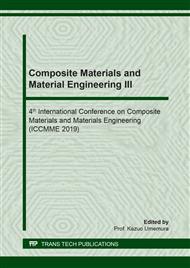[1]
Erukulla, S. (2011). Refining a laboratory procedure to characterize change in hot-mix asphalt surface friction. Transportation Research Board, Annual Meeting CD-ROM, 17p.
Google Scholar
[2]
Forster, S.W. (1989). Pavement microtexture and its relation to skid resistance. Transportation Research Record 1215, Transportation Research Board, TRB, National Research Council, Washington D.C., pp.151-164.
Google Scholar
[3]
Forschungsgesellschaft für Straßen- und Verkehrswesen (2012), Merkblatt zur Bewertung der Straßengriffigkeit bei Nässe (M BGriff), FGSV Verlag, Köln, Ausgabe.
Google Scholar
[4]
Ech, M., Yotte, S., Morel, S., Breysse, D. and Pouteau, B. (2012). Qualification of wearing course material surface evolution after durability test. Construction and Building Materials, Volume 35, p.313–320.
DOI: 10.1016/j.conbuildmat.2012.02.081
Google Scholar
[5]
Senga, Y., Dony, A., Colin, J., Hamlat, S. and Berthaud, Y. (2013). Study of the skid resistance of blends of coarse aggregates with different polish resistances. Construction and Building Materials, Volume 35, p.313–320.
DOI: 10.1016/j.conbuildmat.2013.07.040
Google Scholar
[6]
Dawei, W., Xianhua, C., Xiaoguang, X., Helge, S., Markus, O. and Bernhard S. (2015). A study of the laboratory polishing behavior of granite as road surfacing aggregate. Construction and Building Materials, Volume 89, pp.25-35.
DOI: 10.1016/j.conbuildmat.2015.04.032
Google Scholar
[7]
Plati, C. and Georgouli, K. (2014). Field investigation of factors affecting skid resistance variations in asphalt pavements. The Baltic Journal of Road and Bridge Engineering 9(2):108-114.
DOI: 10.3846/bjrbe.2014.14
Google Scholar
[8]
Ðokic´, O., Matovic´, V., Eric´, S. and Šaric´, K. (2015). Influence of engineering properties on Polished Stone Value (PSV): A case study on basic igneous rocks from Serbia. Construction and Building Materials, Volume 101, pp.1088-1096.
DOI: 10.1016/j.conbuildmat.2015.10.033
Google Scholar
[9]
Voller, T.W. and Hanson, D.I. (2006). Development of laboratory procedure for measuring friction of HMA mixture – phase 1. NCAT Report No. 06-06, National Center for Asphalt Technology.
Google Scholar
[10]
Nitta, N., Saito, K. and Isozaki, S. (1990). Evaluating the polishing properties of aggregate and bituminous pavement surfaces by means of the penn state reciprocating polishing machine. Surface Characteristics of Roadways, 194 International Research and Technologies, ASTM SPT 1031, W.E. Meyer, and J. Reichert, Eds., American Society for Testing and Materials, Philadelphia, PA, pp.113-126.
DOI: 10.1520/stp23357s
Google Scholar
[11]
Dewey, G.R., Robords, A.C., Armour, B.T., and Muethel, R. (2001). Aggregate wear and pavement friction. Transportation Research Board, Annual Meeting CD-ROM, 17p.
Google Scholar
[12]
Michael, H. and Jason, M. (2017). Evaluation of laboratory friction performance of aggregates for high friction surface treatments. NCAT Report 17-01, National Center for Asphalt Technology.
Google Scholar
[13]
Magnoni, M., Giustozzi, F., Toraldo, E. and Crispino, M. (2016). Evaluation of the effect of aggregate mineralogy and geometry on asphalt mixture friction. J Civil Environ Eng 6:223.
DOI: 10.4172/2165-784X.1000223
Google Scholar
[14]
Bureau of Testing, Research and Development Department of Highway (1996). Standard testing. Bangkok, Thailand.
Google Scholar
[15]
Nokkaew, N. (2007). Highway material testing. TPA Book, Bangkok, Thailand.
Google Scholar
[16]
British Standards Institution (2009). Determination of the polished stone value. BS EN ISO 1097-08, Test for mechanical and physical properties of aggregates – Part 8, BSI, London, UK.
Google Scholar


